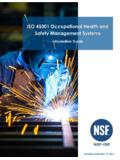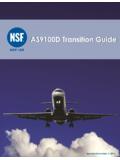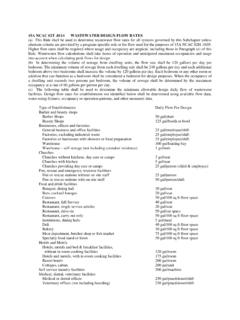Transcription of 2011 NSF International Household Germ Study Executive …
1 2011 NSF International Household Germ Study The Public Health and Safety OrganizationTM. Summary of Findings NSF International , an independent public health organization, sought to examine the difference between perception and reality when it came to where germs lurk in the home. Through a swab analysis of 30 common items in the households of 22 volunteer families, NSF International found some surprising results. The biggest misconception identified through the Study was that the bathroom is the dirtiest place in the house when in fact the kitchen had the most germs.
2 NSF swabbed for Coliform bacteria - a family of bacteria that includes Salmonella and E. coli and is an indicator of potential fecal contamination and found that Coliform was found on: More than 75% of dish sponges/rags 45% of kitchen sinks 32% of counter tops 18% of cutting boards This compares to the bathroom where areas with the most Coliform only included: 27% of toothbrush holders 9% of bathroom faucet handles According to the studies' findings, the areas in which food is prepared actually contained more bacteria and fecal contamination than many other places in the home.
3 Other findings include: Breeding Environment for Germs: Warm and moist environments are breeding grounds for germs. NSF's analysis shows sponges and coffee reservoirs, which may not be cleaned as frequently as they should be, were in the top 10 germiest places in the home. Materials that Hold Germs: Smooth, cold surfaces tend to harbor less germs. NSF's analysis shows that keys, money, computer keyboards, and game controllers did not have a lot of germs. About NSF International : NSF International is an independent, not-for-profit organization, helps protect consumers by certifying products and writing standards for food, water, dietary supplements and consumer goods to minimize adverse health effects and protect the environment ( ).
4 NSF International 789 N. Dixboro Road, Ann Arbor, Michigan 48105. 800-NSF-MARK | | Property of NSF International 2011 NSF International Household Germ Study The Public Health and Safety OrganizationTM. Detailed Swab Analysis A testing swab is essentially a large Q-tip saturated with a sterile liquid that helps pick-up the germs. Each volunteer was provided a swabbing kit that included a swab for each of the 30 Household items to be analyzed. Volunteers were instructed to rub the wet swab tip in a turning motion across a 3x3 inch (10x10 cm) area of each of the 30 items and place back into the swab container without touching the tip to anything else to be analyzed by NSF Microbiologists.
5 Coliform present in 81% of households: Over 30 surfaces were tested in 22 households for Coliform bacteria. Coliforms (a family of bacteria that includes Salmonella and E. coli) are an indicator of potential fecal contamination. In the Study , Coliforms were primarily found on surfaces in the kitchen and the bathroom and also on many personal items. Coliforms were present in over 81% of the households and on 26 of the 30 items tested. We observed that Coliforms were most prevalent on items in the kitchen. Over 75% of the families had Coliform on the dish sponge/rag, 45% in the kitchen sink, 32% on the counter top and 18% on the cutting board.
6 The top items and percentage of households that had coli form are detailed below. Sources of Coliforms are unwashed produce, raw meat and poultry, not washing hands after using the bathroom and pets. is a member of the Coliform family and was found in the pet bowl from two families. It was found on less than 1% of all surfaces sampled in the survey. Yeast and mold present in 31% of households Yeast and mold were found 31% of the households. Yeast and mold are considered to have a negative impact on health since they may elicit an allergenic response in a certain percentage of the population.
7 The kitchen again led the way for households in the survey: 86% of families had yeast and mold on the dish sponge/rag 50% in the coffee reservoir of the coffee maker 68% of families had yeast and mold on the computer key board 64% on the toothbrush holder 59% on the video game controller 55% on the remote control 55% on the pet toy NSF International 789 N. Dixboro Road, Ann Arbor, Michigan 48105. 800-NSF-MARK | | Property of NSF International 2011 NSF International Household Germ Study The Public Health and Safety OrganizationTM. Yeast and mold was found on moist, wet items such as the dish sponge and coffee reservoir, and on many of the items that people typically use while eating.
8 People tend to eat at their computers over the key board, while they watch TV. and play video games. Staphylococcus aureus (Staph) present in over 5% over households Staph was present in over 5% of households surveyed. Staph is a MRSA indicator as defined by the Mayo clinic: Methicillin-resistant Staphylococcus aureus (MRSA) infection is caused by a strain of staph bacteria that's become resistant to the antibiotics commonly used to treat ordinary staph infections. Specifically related to staph findings: Pet toy had staph in 23% of these households Dish sponge/rag in 18% of households Refrigerator handle in 14% of households Toothbrush holder in 14% of households Pet bowl in 14% of households Remote control in 14% of households Video controller in 14% of households Pens in 14% households NSF International 789 N.
9 Dixboro Road, Ann Arbor, Michigan 48105. 800-NSF-MARK | | Property of NSF International 2011 NSF International Household Germ Study The Public Health and Safety OrganizationTM. About the Survey As of January 17, 2011, 22 volunteer families had 30 locations sampled for germs within their homes and car. The survey included items in the kitchen, bathroom as well as other commonly used devices such as cell phones and items like purses for the presence of bacteria, yeast and mold. The size of the test area was about the size of a standard yellow sticky note from 3M, roughly 3 X 3 inches.
10 An Examination of Perception vs. Reality Before testing these items, the volunteers were asked to rate the items they thought would be the dirtiest. Below is a comparison of what volunteers thought were the dirtiest items in the house vs. what the swab analysis actually found to be true. Following is a list of what were perceived to be the germiest items in the home versus the actual germiest items (ranked from highest to lowest in germ count): Volunteers thought: Actual: 1. Toothbrush holder 1. Dish sponge/rag 2. Dish sponge/rag 2. Kitchen sink 3. Money 3.











